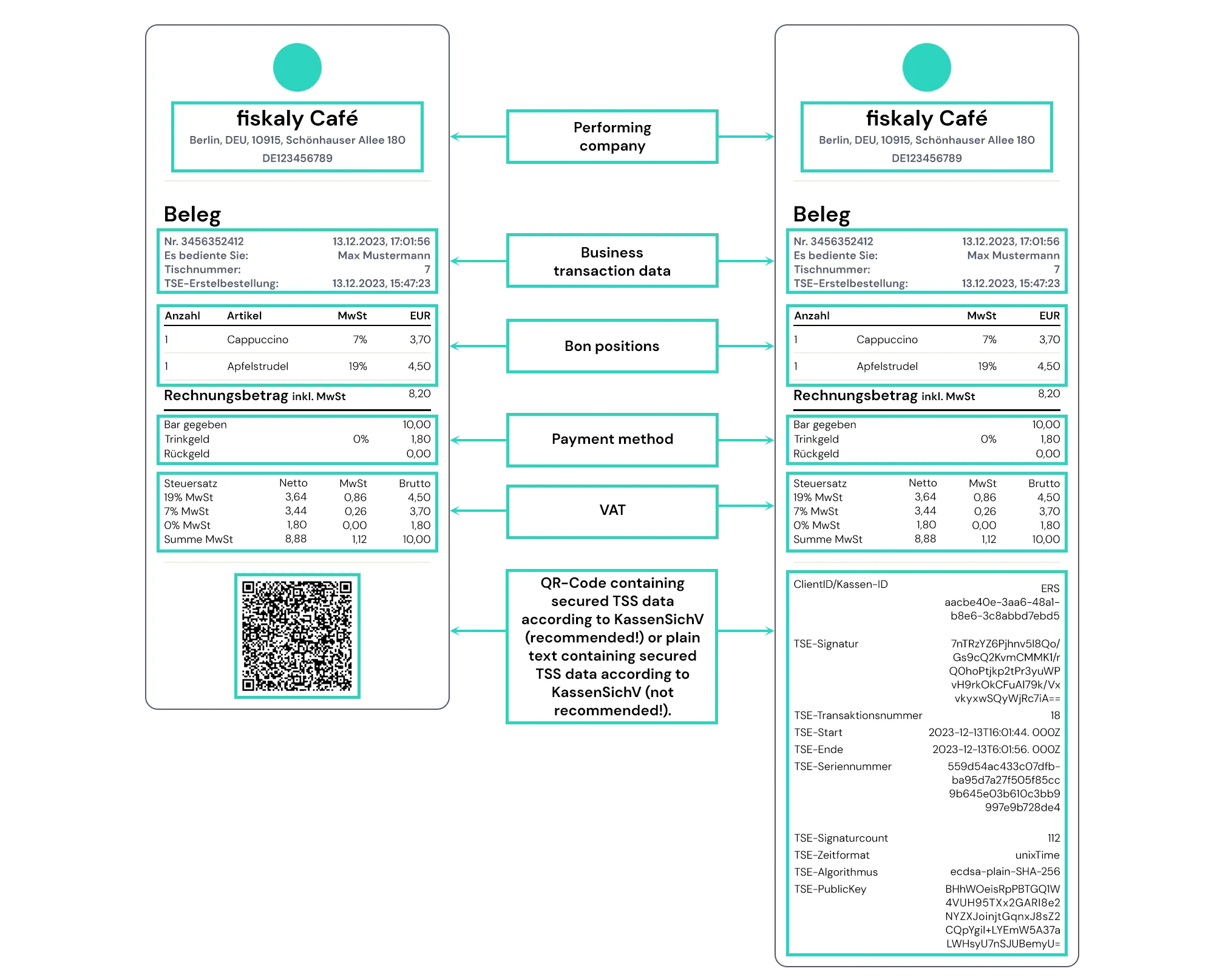QR code replaces legible TSS signature on receipt
On 25 June 2021, the Bundesrat approved the ordinance amending the Cash Security Regulation. (2)(4) The addition to § 6 sentence 2 KassenSichV makes it possible that certain information does not have to be printed on a receipt in a form that can be read by a human being, but can be displayed in a QR code. This means that the size of the receipt can be reduced. Section 6 paragraph 2 of the KassenSichV is worded as follows. "The information according to paragraph 1 must be
- be legible to anyone without machine assistance, or 2. be readable from a QR code.
The QR code according to paragraph 2 number 2 must correspond to the digital interface of the tax authorities (DSFinV), which is prescribed for the respective associated type of recording system. The digital interface shall be published on the website of the Federal Central Tax Office, as amended from time to time."
Source: Bundesrat Drucksache 438/21 p. 8.
Subject to paragraph 2, this Ordinance shall enter into force the day after promulgation.
(Update 2024) To ensure compliance with KassenSichV starting from January 1, 2024, the receipt must include not only the TSS data but also the serial numbers of both the electronic record-keeping system (ERS) and the TSS. We recommend to store this data in the QR code.
Sustainable development
The addition in § 6 sentence 2 KassenSichV makes it possible to print the signature data in a QR code. Previously, all data had to be printed in a human-readable form. This means that this data no longer has to be displayed twice on the receipt if a QR code has already been printed on the receipt. This means that cash register receipts will be shorter. It is estimated that this change will save 108 000 km of paper annually.
The structure and technical specifications for the QR code must comply with the digital interface of the tax authorities (DSFinV). For cash register systems, a digital interface of the financial administration for cash register systems (DSFinV-K) is defined.
Save paper - use QR codes
The TSS data (=secured TSS data according to KassenSichV) should be stored in the QR code. This eliminates the need to print the TSS plain text on the receipt. This is the current recommendation of the tax authorities. In the event of a cash register inspection, the QR code simplifies the process. Shorter receipts save paper and therefore money. In addition, thermal paper pollutants are avoided and the environment is protected.
 The first receipt on the left shows the abbreviated version with the secured TSS data stored in the QR code. The second receipt on the right shows a receipt with printed plain text of the secured TSS data according to KassenSichV. Here, the difference in length and thus the saving of resources can be clearly seen.
The first receipt on the left shows the abbreviated version with the secured TSS data stored in the QR code. The second receipt on the right shows a receipt with printed plain text of the secured TSS data according to KassenSichV. Here, the difference in length and thus the saving of resources can be clearly seen.
Alternatively, you can switch to the digital fiskaly receipt and thus dispense with thermal paper altogether. You will find more information about the fiskaly receipt below.
QR code advantages overview:
- Cash register inspection is significantly simplified
- Faster verification of receipts
- Paper savings → Costs are reduced
- Thermal paper pollutants are reduced → Environment is protected
- Aesthetically more beautiful receipts
fiskaly receipt:
The "extra step" with fiskaly is the completely electronic receipt issuing. With the fiskaly receipt (interface) it is now possible to hand over the receipt 100% electronically and therefore climate neutral. For example, the handover can be done easily by a QR code. At the end of a transaction, the seller receives a QR code on his device. The customer can scan this QR code and receive his electronic fiskaly receipt directly on his device. Alternatives are sending the receipt by e-mail or SMS.
fiskaly receipt advantages overview:
- Digital receipt → no paper, no additional costs
- Seamless and fast integration through API interface
- Modern way of receipt issuing (QR code, email, SMS)
- No contact with thermal paper pollutants
- Aesthetically customizable design
Note:
It is estimated that this change will save 108,000 km of paper annually in Germany.
The example below illustrates how many resources can be saved annually by this change.
Example calculation of resource saving
The example is from the Regulation on the Amendment of the Cash Security Regulation and illustrates how many resources can be saved annually through this amendment:
"Here it is assumed that the data so far takes up an average length of 3 cm on the cash register receipt and that approx. 40 percent of the receipts are either issued electronically or do not contain a QR code. With an estimated 6 billion receipts per year, this leads to a paper saving of 108,000 km of paper. With an average length of 50 m per receipt roll and an average cost of 1 euro per receipt roll, the annual savings amount to 2.1 million euros."
Drucksache 19/29085 (28.4.2021), p. 15.
fiskaly supports this sustainable development of printing a QR code instead of printing the readable signature. In this way, paper consumption can be reduced by the document output requirement and thus resources can also be conserved.
fiskaly eReceipt
The "extra step" with fiskaly is the completely electronic receipt issue. With the fiskaly eReceipt, it will be possible in the future to hand over the receipt 100% electronically and thus in a climate-neutral way.
More details will follow in summer 2022.
Sources:
- German Bundestag Drucksache 19/29085 28.04.2021
- Bundesrat Drucksache 438/21 21.05.2021
- Bundesrat Drucksache 438/1/21 14.06.2021
- Bundesrat Drucksache 438/21 (Beschluss) 25.06.2021
